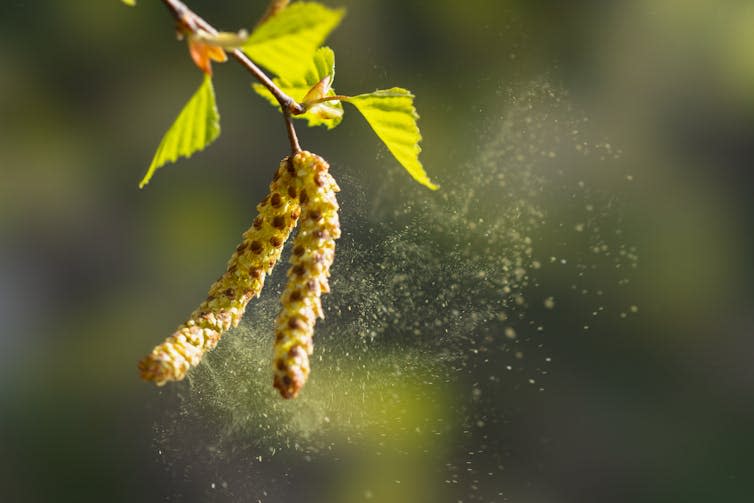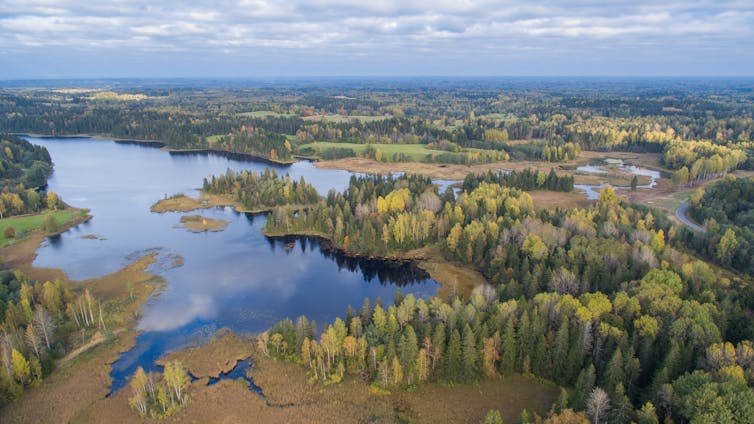You don’t have to read the news or scroll through Instagram for long to come across the latest example of a rare and beautiful species going extinct. Since 1500 AD, at least 705 vertebrate species and 571 plant species have become extinct.
Humans have now taken over half of the Earth’s surface for agriculture and urban areas, which is the main cause of the recent decline in global biodiversity.
But humans didn’t suddenly appear in the year 1500. Early humans were burning down the African savannas some 400,000 years ago, and possibly much earlier.
There is evidence that Neanderthals were changing the plants and landscapes of Europe around 125,000 years ago. And while there is still some debate, humans were likely the decisive factor in the extinction of most of the once widespread megafauna on Earth in the past 100,000 years.
Then, about 12,000 years ago, the most recent ice age ended and a new geological period began, known as the Holocene. This marked a major shift in human-environment relationships, as people independently transitioned from foraging to agriculture in many different places around the world.
Whether this transition looked like rice fields in China, wheat fields in the Levant, or the production of corn and squash in Mesoamerica, humans were increasingly changing the landscape. Domesticated livestock soon followed in many places.
All of this had a surprising impact on biodiversity. Our latest research shows that agriculture and other human-driven changes to ecosystems increased diversity as often as they decreased it.
Fossil pollen tells us about past vegetation
To reconstruct how vegetation has changed over thousands of years, scientists look at fossilized pollen grains found in layers of sediment and organic matter (such as decomposed twigs and leaves) in places like peat bogs and lakes. The timing of the layers and the variety of pollen found create a picture of the changing diversity of plant species in the local landscape over time.

By analyzing pollen data from the Neotoma Paleoecological Database, we found that plant communities became increasingly diverse throughout the Holocene across most of the Northern Hemisphere, beginning in Europe around 9,000 years ago. Surprisingly, these increases in diversity are often associated with increasing levels of human activity.
In the Southern Hemisphere, the results are more mixed. In Africa and South America, increased human land use decreased plant diversity, and decreased land use increased diversity. Nevertheless, the turnover rate – how quickly different types of plants change – increased with human land use on all continents. Humans have long been a major driver of vegetation change.
Agriculture created an irregular landscape
After the end of the last ice age, the climate warmed, conditions generally became somewhat wetter, and forests spread across newly thawed areas – particularly in the Northern Hemisphere. It is in these extensive, early Holocene forests that we find the strongest overall associations between increasing human presence and increased plant diversity in the Holocene.
In contrast, plant species diversity declined in open, grassy areas, such as the North American plains and the savannas of Africa, as human pressure increased.
The relationship is best seen in Europe, where two major increases in plant growth and biodiversity found in pollen samples roughly coincide with the two major migrations of people into Europe during the Holocene.
The first began about 9,000 years ago with the northward and westward movement of Neolithic (farming) populations from the Fertile Crescent in the Middle East into Europe. The second began about 5,000 years ago during the Early Bronze Age, when horse-riding herders from the Central Asian steppe – the Yamnaya – moved westward into Europe.


We think that these newcomers to Europe would have cleared some, but not all, of the forests to make way for animals and crops and to create their own farms. Grasses and other plants that thrive in disturbed soil would have moved in. This would have created a diverse landscape full of patches of different vegetation.
Patching a forest is easier than patching an open grassland because it is easier to cut trees and for plants in the open ground to colonize these gaps. Patching an open, grassy site means planting trees (and allowing them to survive) in places that are too dry or too cold to support tree growth. We believe that the fact that it is easier to patch a forest may have caused some of the historical differences in vegetation patterns between different parts of the world.
Land without people may have less biodiversity
Many people now advocate increasing biodiversity by minimizing human impact on landscapes. This often takes the form of rewilding, which aims to “let nature lead.”
However, our results suggest that in many places – although not all – minimally human-modified landscapes had fewer plant species. Often, human disturbances have enhanced biodiversity rather than damaged it. Many of the most biodiverse places in Europe are now traditionally managed, low-intensity agricultural lands such as alpine pastures and the dehesas And mounted in Spain and Portugal.
In light of this, removing people from landscapes to make ecosystems healthier and more diverse can sometimes be counterproductive. While perhaps surprising, our research reveals that biodiversity in many places is flourishing because of, not despite, thousands of years of human interaction with Earth’s ecosystems.


Don’t have time to read as much about climate change as you’d like?
Instead, get our award-winning weekly digest in your inbox. Every Wednesday, The Conversation’s environment editor writes Imagine, a short email that digs a little deeper into just one climate issue. Join the 35,000+ readers who have subscribed so far.
This article is republished from The Conversation under a Creative Commons license. Read the original article.
Jonathan D. Gordon receives funding from a Leverhulme Trust Research Centre—The Leverhulme Centre for Anthropocene Biodiversity, grant no. RC-2018-021
Brennen Fagan undertakes his postdoctoral position through the Leverhulme Centre for Anthropocene Biodiversity, funded by the Leverhulme Trust, grant no. RC-2018-021.